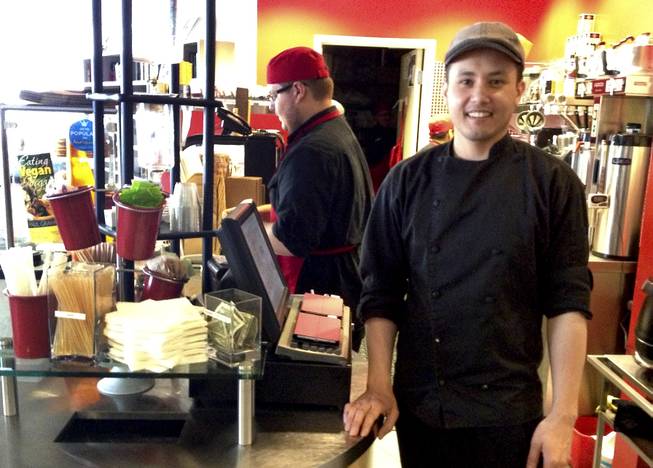
Peter Bastien, the owner and executive chef of Bronze Cafe at The Center, 401 S. Maryland Parkway, is seen Thursday, Jan. 30, 2014.
Friday, Jan. 31, 2014 | 2 a.m.
Is a "gayborhood" the next development for downtown Las Vegas?
Maybe.
Investors are pooling their money to buy swaths of property downtown in the hopes of creating an affordable gay neighborhood.
Realtor Jack Levine is one of about four investors. He said lawyers are poring over legal documents this week to form a corporation, and the group hopes to start buying property soon. He would not specify where they are looking.
“I think it needs to be walkable but further from the Arts District or Fremont Street,” said Levine, who has lived downtown since 1985. “Walkability is a big part of it.”
If a gayborhood does spring up downtown, it likely will be a good thing for the entire area, experts who study urban livability said. Many gay couples don’t have children, so they have more expendable income to improve their properties, increasing the value of other land nearby.
A CNN report in 2012 noted that gay neighborhoods with the densest population of same-sex couples were among the nation’s most expensive, including San Francisco’s Castro District, where about 14 percent of the households are made up of male couples. There, homes were valued at roughly $671 per square foot, the report said.
Gay neighborhoods also highlight a community’s acceptance of alternative lifestyles or ideas, experts said.
In his book “The Rise of the Creative Class,” urban studies theorist Richard Florida, now at the University of Toronto, writes about the link between creativity and a “gay index,” a measure of a city’s gay tolerance. More creative people tend to be more tolerant of differing views, so gay residents may be more accepted.
Over the past several decades, gayborhoods began to sprout in the Huntridge and John S. Park neighborhoods, just south of Charleston Boulevard between Las Vegas Boulevard and roughly Maryland Parkway, but they fizzled out both during the boom, when property values skyrocketed in the early to mid-2000s and people sold their homes for large profits, and during the recession, when many people lost the urge to buy homes, Levine said.
Levine and co-investors now are betting that downtown is ready for a gay revival.
David Mozes, general manager of the Bronze Cafe at The Center, which supports the lesbian, gay, bisexual, transgender and queer community, said a group of residents met weekly, even before The Center opened, to figure out “what we needed in order to create more sense of community or some sort of gayborhood downtown.”
Many of their suggestions included simple improvements to downtown’s infrastructure: sidewalks, more street lights, wayfinding signs and trash cans.
Now that Zappos.com has moved downtown and the Downtown Project, whose partners include Zappos CEO Tony Hsieh, is investing in the area, Mozes sees some of that happening.
“A lot of urban planning-type foundational concerns are being met now,” Mozes said. “There are even sidewalks going around vacant lots just up the street from here. Those are off-site improvements that a developer now doesn’t have to do. That makes it more attractive to a developer, whether for a gayborhood or anything else.”
Aside from boosting property values, what other good can a gayborhood serve?
Cathy Brooks, owner of the Hydrant Club, a social club and dog training facility on East Fremont and 9th streets, said it would have been much more difficult for her to come out 17 years ago if she hadn't lived in San Francisco.
“Thank goodness I was there at the time,” she said. “I was in a city where I ... was accepted. If there is a burr on the underblanket of feeling really, really at home here, it’s: Where are my gay people?”
Brooks hopes a gay neighborhood might lead to people forming groups based on common interests — say, dog walking or playing chess.
That’s just what Levine and his co-investors foresee.
“We want the same thing everybody wants, but the question is: Do people have to be there first and then the businesses start up?" he said. "Or do you bring in the businesses and then the residents move in? I think it’s the people first.”
Joe Schoenmann doesn’t just cover downtown; he lives and works there. Schoenmann is Greenspun Media Group’s embedded downtown journalist, working from an office in the Emergency Arts building.

Join the Discussion:
Check this out for a full explanation of our conversion to the LiveFyre commenting system and instructions on how to sign up for an account.
Full comments policy